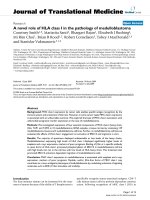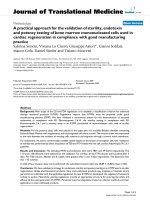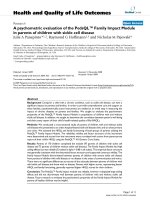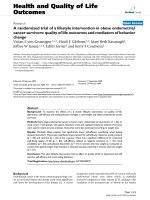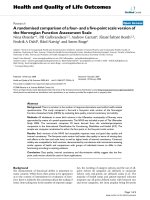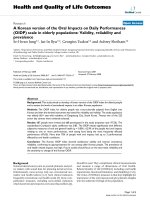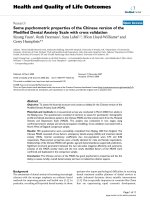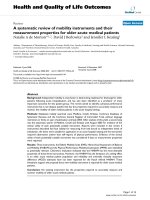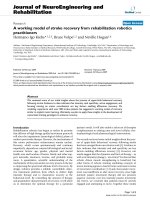Báo cáo hóa học: " A Korean version of the Oral Impacts on Daily Performances (OIDP) scale in elderly populations: Validity, reliability and prevalence" potx
Bạn đang xem bản rút gọn của tài liệu. Xem và tải ngay bản đầy đủ của tài liệu tại đây (281.96 KB, 8 trang )
BioMed Central
Page 1 of 8
(page number not for citation purposes)
Health and Quality of Life Outcomes
Open Access
Research
A Korean version of the Oral Impacts on Daily Performances
(OIDP) scale in elderly populations: Validity, reliability and
prevalence
Se-Hwan Jung
†1
, Jae-In Ryu*
2
, Georgios Tsakos
†2
and Aubrey Sheiham
†2
Address:
1
Department of Preventive and Public Health Dentistry, Kangnung National University, Gangneung, Republic of Korea and
2
Department
of Epidemiology and Public Health, University College London, London, UK
Email: Se-Hwan Jung - ; Jae-In Ryu* - ; Georgios Tsakos - ;
Aubrey Sheiham -
* Corresponding author †Equal contributors
Abstract
Background: This study aimed to develop a Korean version of the OIDP index for elderly people
and to assess the levels of sociodental impacts in an older Korean population.
Methods: The OIDP index for elderly people was cross-culturally adapted from English into
Korean and then the derived instrument was tested for reliability and validity. The study population
was elderly (65+ year-old) residents of Gangneung City, South Korea. Twenty two of the 222
senior day centres were randomly selected.
Results: 687 people were invited and 668 participated in the study (response rate: 97.2%). The
standardized Cronbach's alpha coefficient was 0.85. The OIDP related significantly with different
subjective measures of oral and general health (p < 0.001). 62.9% of the people had oral impacts
relating to one or more performances, with eating food being the most frequently affected
performance (47.6%). More than 70% of people with oral impacts had up to 3 performances
affected by oral health conditions.
Conclusion: The Korean OIDP index showed satisfactory validity and internal consistency
reliability, confirming its appropriateness for use among older Korean people. The prevalence of
oral health related impacts was high. Future studies should focus on the test-retest reliability and
the sensitivity to change of the Korean OIDP.
Background
National dental surveys aim to provide planners and pol-
icy makers with sound data for planning dental services.
Unfortunately, most surveys only use conventional nor-
mative oral health indices [1,2]. Such clinical indicators
frequently overestimate oral health needs [3]. More com-
prehensive measures, including socio-dental indicators
which have been developed to overcome this problem [4],
should be used. They complement clinical measurements
and measure a range of dimensions of Oral Health-
Related Quality of Life (OHRQoL) including oral health
impairments, functional limitation, and disability [2,5,6].
The virtue of OHRQoL measures is that they highlight the
importance of the oral impacts and give planners insights
into the subjective feelings of the population.
Published: 27 February 2008
Health and Quality of Life Outcomes 2008, 6:17 doi:10.1186/1477-7525-6-17
Received: 8 June 2007
Accepted: 27 February 2008
This article is available from: />© 2008 Jung et al; licensee BioMed Central Ltd.
This is an Open Access article distributed under the terms of the Creative Commons Attribution License ( />),
which permits unrestricted use, distribution, and reproduction in any medium, provided the original work is properly cited.
Health and Quality of Life Outcomes 2008, 6:17 />Page 2 of 8
(page number not for citation purposes)
The Oral Impacts on Daily Performance (OIDP) [7] is one
of the most widely used sociodental indicators. The theo-
retical framework on which the OIDP is based is modified
from the WHO's [8] International Classification of
Impairments, Disabilities and Handicaps [9]. The main
modification is that different levels of the concepts are
established: oral status or impairments, intermediate
impacts (pain, discomfort, functional limitation or dissat-
isfaction with appearance), and ultimate impacts which
cover the concepts of disability and handicap. The OIDP
focuses on the third level of measurement, thus assessing
oral impacts on the ability to perform daily activities. It is
easy to use and has been successfully tested for reliability
and validity in adult and elderly populations in different
settings [7,10-15]. Before using an OHRQoL measure in a
new setting, it is necessary to re-establish its psychometric
properties. Therefore, the first objective of this study is to
develop and validate a Korean version of the OIDP index
for elderly people. The second objective is to assess the
levels of sociodental impacts in an older Korean popula-
tion.
Methods
The research sites for this study were located in Gangne-
ung City, the North-East of South Korea. The study popu-
lation was residents of this city, aged over 65 years. The
sampling frame referred to the 222 senior day centres of
the city. These are places where retired free-living senior
adults meet, communicate and participate in recreational
activities. Twenty two of the 222 senior day centres were
randomly selected for this study.
To cross-culturally adapt the OIDP for use among Korean
elderly people, the English OIDP index for elderly people
[15] was first translated into Korean by three independ-
ently working Korean scholars with a good knowledge of
English. Because 19.2% of the elderly are illiterate in
Korea [16], the Korean version of the OIDP index needed
to be a questionnaire for face to face interviews. The trans-
lated questionnaire was first tested on 20 people in a sen-
ior day centre. After the interviews, the interviewers had
informal conversations with the participants about the
questionnaire. Minor modifications were made to the for-
mat of questionnaires and to the wording. Secondly, the
backward translation of the draft version of the Korean
OIDP into English was carried out by experts in foreign
languages at the Institute of Kangnung National Univer-
sity in Korea. Then, experts on dental public health, lan-
guage and translation compared the back translation with
the original English version of questionnaire. Finally, the
backward translation of English OIDP was verified with
the original developers of the OIDP at University College
London.
A second pilot study was carried out prior to the main
study to test the feasibility of questionnaire administra-
tion under field conditions, as well as the understanding
of the content of the questionnaire under investigation.
Another 20 elderly people from a senior day centre partic-
ipated in this pilot testing of the oral health assessment
and questionnaire forms. The pilot study confirmed the
feasibility of the methodology with some modifications.
An examiner was trained and calibrated to the 2000 and
2003 National Oral Health Survey. He was fully aware of
the form and criteria for the oral examination of National
Survey. The interviewers were briefed about the purpose
and process of the study. They had experience in inter-
viewing people for oral health related questionnaires and
had worked in Kangnung Dental College as researchers.
The manual for the interviewers of the OIDP was com-
pleted based on the discussion from pilot tests.
The main study was implemented on elderly people
attending 22 senior day centres. Information letters were
sent to the selected senior day centres at least one week
prior to the date of the data collection. Data were collected
using the clinical oral health assessment form and the oral
health questionnaires. Clinical dental examinations were
used to determine whether subjects were dentate or eden-
tulous, count the number of natural teeth present and
assess the need for restorative and prosthetic treatment.
The oral health questionnaire recorded data on demo-
graphic information, perceived oral health conditions,
satisfaction with oral health status, perceived general
health conditions, and pain using a visual analogue scale
(VAS). A Visual Analogue Scale is a measurement instru-
ment that tries to measure a characteristic or attitude that
is believed to range across a continuum of values and can-
not easily be directly measured [17].
The study was ethically approved by the Institutional
Review Board (IRB) in Kangnung National University
Dental College (IRB Letter No. 2004-02). Individual pos-
itive consent was sought for the clinical oral examination
and the questionnaire-led interview. Subjects were free to
withdraw from the study at any stage. Local city councils
and health authorities in the study areas were contacted to
gain permission and co-operation. Every participant
received information on their measured oral and general
health conditions.
Data analysis
Each performance score of OIDP was calculated by multi-
plying frequency (0–5) and severity scores (0–5). Then
these scores for the 10 performances were summed up.
Finally the overall OIDP score was the sum divided by
maximum possible score (5 frequency × 5 severity scores
× 10 performances) and multiplied with 100 to give a per-
Health and Quality of Life Outcomes 2008, 6:17 />Page 3 of 8
(page number not for citation purposes)
centage score. In addition to the OIDP score, the extent of
OIDP impacts was also reported. This is an alternative way
of quantifying oral impacts, previously suggested for the
OIDP [18] and used in the Child-OIDP [19], and refers to
the number of OIDP performances with impacts (PWI)
affecting a respondent's quality of life over the past six
months.
Face and content validity were tested in the pilot study
with regard to content, wording, scoring method, and eas-
iness and appropriateness of the questionnaire adminis-
tration. Content validity measures whether the
components of the scale or item cover all aspects of the
attribute to be measured or the content of the variables
matches the name which it has been given [20]. The crite-
rion validity is defined as the correlation of a scale with
some other measure of the trait under study, ideally a
'gold standard', while the construct validity, described as
probably the most important approach to validity
[21,22], tests logical constructs by assessing the relation-
ship of the instrument under test with measures of other
related constructs. As the OIDP is intended to be used in
dental needs assessment, perceived need for dental treat-
ment was chosen as a proxy measure for the criterion
validity testing, while pain visual analogue scales, per-
ceived oral health status, satisfaction with oral health sta-
tus and perceived general health status for the construct
validity testing [23] of the Korean OIDP. Due to their
skewed frequency distribution, the pain VAS scores were
categorised into three, none (0), low (1–5), and high
(6–10) pain experience. The OIDP scores were not nor-
mally distributed and the Kruskal-Wallis test was used for
analyzing the relationship between OIDP scores and sub-
jective questions. In addition, the Spearman's rank corre-
lation coefficient was used for the association between the
OIDP scores and the pain VAS scores. Internal reliability
of the OIDP was tested by inter-item correlations, cor-
rected item-total correlations, standardised alpha coeffi-
cient and alpha if item deleted [24]. Finally, the
relationships between the OIDP scores and clinical meas-
ures of restorative and prosthetic treatment needs were
assessed through the use of Kruskal-Wallis test. Treatment
need variables were categorised into three groups: 1)
restorative treatment needs: no need, one surface restora-
tion, pulp care with restoration or extraction; and 2) pros-
thetic treatment needs: no need, need only in one jaw,
needs in both jaws. SPSS version 13.0 for Windows was
used for the analysis of data in this sample. The cut-off
level for statistical significance was 0.05 [25].
Results
687 people were invited to participate in this study and
668 agreed with a response rate of 97.2%. The sociodemo-
graphic distribution of the sample is shown in Table 1.
The age ranged from 65 to 93 and the mean of it was 75.5
± 6.0 years. There were slightly more females than males.
Most participants had not finished elementary school
(86%). More than half of the people had dentulous den-
titions in both jaws and around a quarter of the study
sample was totally edentulous (Table 2). The mean
number of permanent natural teeth present was 11.6 ±
9.8. Clinically 36.4% of subjects were assessed to need
restorative treatment, while in terms of prosthetic treat-
ment 23.5% of needed treatment in one jaw and 20.7% in
both jaws. 64.6% of the respondents thought they need
dental treatments and 62.4% answered that they have
poor oral condition. Slightly less than half of the subjects
(43.1%) were satisfied with their oral conditions.
The criterion and construct validity of OIDP index were
assessed through its association with several subjective
health status variables (Table 3). Participants with per-
ceived needs for dental treatment had much higher OIDP
scores than those who did not have perceived need for
treatment (p < 0.001). Similarly, people who reported
worse oral health perceptions or had higher pain VAS
scores had significantly higher OIDP scores than their
counterparts with better oral health perceptions or lower
pain scores respectively (p < 0.001 for both). The associa-
tion between pain VAS score and the OIDP score was also
significant (p < 0.001), with a relatively strong correlation
coefficient of 0.42. In relation to construct validity tests,
people with higher levels of satisfaction with oral health
and perceived general health status had lower OIDP
scores than those with lower levels of satisfaction and per-
ceived general health status respectively (p < 0.001). All
those relationships showed a clear trend with OIDP
scores, not only a difference between the extreme groups;
the worse the perception, the higher the OIDP score,
which indicates higher level of oral impacts.
Table 1: Socio-demographic characteristics of the Korean elderly
subjects (n = 668)
Demographic information Percent
Age 65–74 years 46.7
over 75 years 53.3
Sex male 49.1
female 50.9
Household status living alone 23.1
living with your husband/wife 42.8
living with children 33.7
other 0.4
Education no formal education 43.0
primary school 42.8
middle school 6.7
high school 6.4
college 1.0
Health and Quality of Life Outcomes 2008, 6:17 />Page 4 of 8
(page number not for citation purposes)
In addition, the OIDP was able to discriminate between
participants with different degrees of treatment needs. The
relationship between the OIDP score and restorative treat-
ment need showed significant trend (p = 0.016), with
worse OHRQoL among participants in higher need for
treatment. Furthermore, the relationship between OIDP
score and prosthetic treatment need of participants
showed a similar pattern (p < 0.001); the mean OIDP
score among subjects with no prosthetic need was 6.3,
while the figures among those with need in one jaw and
need in both jaws were 9.0 and 10.4 respectively.
Table 4 shows that the inter-item correlation coefficients
among the 10 items scores of the OIDP index ranged from
0.13 to 0.74. None of the scores were negative suggesting
that the items were homogenous. Also, the correlations
were not high enough for any item to be redundant. Cor-
rected item-total correlations coefficients ranged from
0.40 to 0.68 (Table 5). Cronbach's alpha coefficient was
0.84 and the standardized alpha was 0.85. When any of
the items was deleted the alpha coefficient did not over-
ride the standardized alpha.
A relatively high percentage of people (62.9%) reported
oral impacts relating to one or more performances. The
distribution of people with oral impacts for the different
performances is shown in Table 6. The most frequently
affected performance was eating food (47.6%). The next
most common impacts related to speaking (24.9%) and
cleaning teeth (19.3%). The extent of oral impacts ranged
from 0 to 10 performances with impacts (PWIs). More
than 70% of people with oral impacts had up to three per-
formances affected from oral conditions; 36.7% had 1
PWI, 21.2% had 2 PWIs, and 15.7% had 3 PWIs (Figure
1).
Discussion
This is the first study to adapt the OIDP index in Korean
and test its validity and reliability on an elderly Korean
population. Considerable efforts were devoted to the
appropriate cross-cultural adaptation of the instrument,
in order to overcome the language and cultural differ-
ences. Failure to deal with those issues can raise critical
questions on the validity of an adapted version of an
index [26]. Structured translation is one of the most
important procedures to avoid this problem. This study
followed the methodology from previous studies on the
OIDP [6,12,15,27,28]. The professional language unit,
consisting of staff who can speak both English and Korean
fluently, undertook the forward and backward transla-
tion. After that the draft was re-examined twice in pilot
studies.
The pilot study provided insights into the understanding
of Korean version of OIDP by Koreans. For example, they
confused the meaning of 'sleeping' because it could be
interpreted as 'sleeping' or 'going to bed' which are the
same word in Korean. 'Sleeping' was complemented with
extra explanation of this performance. Second, some of
Table 2: Percentage distribution of clinical and subjective status
in Korean elderly subjects (n = 668)
Clinical status and needs Categories Percent
Denture status both edentulous 22.5
upper edentulous 14.7
lower edentulous 3.7
both dentulous 59.1
Number of natural teeth 0 22.5
1–10 27.2
11–20 23.8
21 or more 26.5
Restorative need no need 63.6
one surface 7.7
pulp care + restoration
or extraction
28.7
Prosthetic need no need 55.8
in one jaw 23.5
both jaws 20.7
Subjective status and needs Categories Percent
Perceived dental treatment
need
1
no need at all 8.9
no need 26.4
fairly need 9.8
need 29.0
high level of need 25.8
Perceived oral health
2
good 18.5
fair 19.1
poor 34.6
very poor 27.8
Pain VAS (categorised) 0 65.4
1–5 21.0
6–10 13.6
Satisfaction with oral health
status
3
satisfied 23.4
fairly satisfied 19.7
not satisfied 31.1
not at all satisfied 25.8
Perceived general health
3
good 18.0
fair 25,2
poor 30.0
very poor 26.7
1
Due to missing cases, analysis carried out on 651 people.
2
Due to missing cases, analysis carried out on 665 people.
3
Due to missing cases, analysis carried out on 666 people.
Health and Quality of Life Outcomes 2008, 6:17 />Page 5 of 8
(page number not for citation purposes)
Table 3: Criterion and construct validity tests for Korean elderly OIDP index and relationship with clinical measures: OIDP scores
(0–100) between different categories of outcome measurements
Variables Categories N Mean (SD) Quartiles P
Subjective health status measures
Perceived dental treatment need (n = 651) no need at all 58 0.9 (2.8) (0.0, 0.0, 0.0) < 0.001
no need 172 3.4 (9.1) (0.0, 0.0, 2.2)
fair level of need 64 3.6 (7.3) (0.0, 0.0, 3.2)
need 189 6.8 (11.0) (0.0, 1.8, 8.6)
high level of need 168 17.8 (20.1) (2.7, 10.2, 25.4)
Perceived oral health (n = 665) good 123 1.9 (6.2) (0.0, 0.0, 0.0) < 0.001
fair 127 2.3 (4.9) (0.0, 0.0, 1.6)
poor 230 7.7 (13.1) (0.0, 2.2, 9.6)
very poor 185 15.8 (19.1) (0.4, 10.0, 20.6)
Pain VAS (categorised) (n = 668) 0 437 4.5 (10.2) (0.0, 0.0, 6.0) < 0.001
1–5 140 8.7 (13.2) (0.0, 2.8, 12.0)
6–10 91 22.1 (21.3) (6.0, 17.6, 31.2)
Satisfaction with oral health (n = 666) satisfied 156 1.8 (6.7) (0.0, 0.0, 0.0) < 0.001
fairly satisfied 131 2.5 (5.7) (0.0, 0.0, 1.6)
not satisfied 207 9.0 (13.6) (0.0, 4.0, 12.0)
not at all satisfied 172 16.1 (19.2) (1.7, 10.0, 20.4)
Perceived general health (n = 666) good 120 3.4 (8.2) (0.0, 0.0, 2.0) < 0.001
fair 168 7.4 (14.5) (0.0, 0.0, 8.3)
poor 200 7.7 (14.6) (0.0, 0.6, 8.4)
very poor 178 11.3 (15.7) (0.0, 6.0, 16.0)
Clinical dental treatment needs
Restorative need no need 425 7.1 (13.4) (0.0, 0.0, 6.0) = 0.016
one surface 51 7.2 (13.2) (0.0, 2.0, 13.4)
pulp care + restoration or extraction 192 9.6 (15.8) (0.0, 3.0, 14.0)
Prosthetic need no need 373 6.3 (13.1) (0.0, 0.0, 8.0) < 0.001
in one jaw 157 9.0 (14.4) (0.0, 0.0, 10.0)
both jaws 138 10.4 (16.0) (0.0, 2.4, 12.0)
Table 4: Reliability analysis of OIDP index for Korean participants: OIDP items Correlation matrix
Performances
Performances 1. 2. 3. 4. 5. 6. 7. 8. 9. 10.
1. eating 1.00
2. speaking 0.39 1.00
3. smiling 0.30 0.48 1.00
4. light physical activities 0.39 0.35 0.22 1.00
5. daily activities 0.38 0.40 0.38 0.73 1.00
6. enjoying contact 0.37 0.53 0.48 0.52 0.74 1.00
7. cleaning teeth 0.37 0.26 0.30 0.13 0.21 0.21 1.00
8. sleeping 0.27 0.25 0.16 0.26 0.32 0.29 0.29 1.00
9. relaxing 0.34 0.21 0.21 0.42 0.37 0.35 0.28 0.41 1.00
10. emotional stability 0.53 0.44 0.43 0.49 0.48 0.54 0.32 0.30 0.42 1.00
Health and Quality of Life Outcomes 2008, 6:17 />Page 6 of 8
(page number not for citation purposes)
them had difficulties exactly setting the time frame for the
reporting of oral impacts when the wording 'in the past 6
months' was used. As a solution the interviewers men-
tioned the exact month that corresponded to the six
months prior to the main study. Those minor modifica-
tions improved understanding of the questionnaires and
all participants in the main study answered without miss-
ing out any item.
The validity of quality of life mainly relied on the subjec-
tive measurement. The rationale for this comes from the
conceptual distinction between health and disease
[15,29]. A normative index measures only biological
pathology, without considering social and psychological
aspects of health. There are well known limitations of the
normative assessment of oral health and needs [30]. Dis-
ease does not always negatively affect subjective percep-
tions of wellbeing [15]. Consequently, clinical oral health
indicators "tell us nothing about the functioning of either
the oral cavity or the person as a whole and nothing about
subjectively perceived symptoms such as pain and dis-
comfort" [31]. In addition to using the relationship
between OIDP and subjective health status measures for
the core assessment of validity, the ability of the index was
also assessed to discriminate between different clinical
status groups.
The results of this study showed that the Korean OIDP for
elderly people is a valid and reliable instrument to meas-
ure OHRQoL. Face and content validity were confirmed in
the pilot study. In this study, all examined relationships
between OIDP score and subjective oral health measures
(perceived dental treatment need, perceived oral health
condition, pain visual analogue scale, satisfaction with
oral health) were statistically significant and showed a
clear trend in the expected direction; the worse the subjec-
tive oral health rating, the higher the OIDP score. Further-
more, in line with previous studies [15,32,33], the OIDP
score was significantly associated with perceived general
health. In addition to using the relationship between
OIDP and subjective health status measures for the core
assessment of validity, the ability of the index to discrim-
inate between different clinical groups was successfully
assessed. Indeed, the OIDP was able to discriminate
between groups with different degrees of treatment need.
Subjects with no need for dental treatment reported sig-
nificantly lower levels of oral impacts than their counter-
parts with low levels of treatment needs, and those, in
turn, had lower levels of impacts than subjects with higher
levels of treatment needs. This significant trend was
observed in relation to both restorative and prosthetic
treatment needs.
Inter-item correlation, corrected item-total correlation,
and Cronbach's alpha indicated this index had excellent
Percentage distribution of the number of OIDP perform-ances affected among those with any impactFigure 1
Percentage distribution of the number of OIDP perform-
ances affected among those with any impact.
Table 6: Percentage distribution of people with positive OIDP
impacts (n = 668)
Positive OIDP performance N%
Any performance affected 420 62.9
Eating 318 47.6
Speaking 166 24.9
Smiling 97 14.5
Light physical activities (housework) 56 8.4
Daily activities (going out) 64 9.6
Enjoying contact 72 10.8
Cleaning teeth 129 19.3
Sleeping 65 9.7
Relaxing 44 6.6
Emotional stability 128 19.2
Table 5: Reliability analysis of OIDP index: Corrected item-total
correlation, Cronbach's Alpha, Standardised Alpha and Alpha if
item deleted
Performances Corrected item-total
correlation
Alpha if item
deleted
1. eating 0.57 0.83
2. speaking 0.57 0.83
3. smiling 0.51 0.83
4. light physical activities 0.58 0.83
5. daily activities 0.67 0.82
6. enjoying contact 0.68 0.82
7. cleaning teeth 0.40 0.84
8. sleeping 0.41 0.84
9. relaxing 0.48 0.84
10. emotional stability 0.68 0.81
Alpha = 0.84
Standardised item Alpha = 0.85
Health and Quality of Life Outcomes 2008, 6:17 />Page 7 of 8
(page number not for citation purposes)
internal consistency. None of the inter-item correlations
was negative and all item-total correlations were above
the minimum recommended level of 0.20 [34] for includ-
ing an item in a scale, hence demonstrating the homoge-
neity of the items. Furthermore, Cronbach's alpha was
much higher than the recommended thresholds for
research purposes and studying groups and higher than
previous studies in other settings [7,15,27].
The overall prevalence of Oral Impacts on Daily Perform-
ance (OIDP) was 63%. That was similar to Tanzanian
(62.1%) [13] and Thai (52.8%) [14] studies on a similar
age group but higher than in other countries [7,15,27,35].
The differences in prevalence may be related to cultural
differences. The comparison of oral health care systems in
six countries reported similar results [36]. There were big
differences in subjective oral health conditions. For exam-
ple, people in Japan, which is close to Korea, were more
likely to answer that their oral conditions were not good.
It is possible that the cultural gap between western and
eastern countries is responsible for the differences. Eating
was the most prevalent performance affected by oral
impacts among the ten items. That was consistent with the
results in other studies [6,11,13-15,19,27,35,37]. The per-
formance with the lowest prevalence of oral impacts was
relaxing (7%). Other studies suggested excluding two
items such as cleaning and light physical activities which
showed the extremely low prevalence from the OIDP [15].
However, our results justify the inclusion of all ten items
in the Korean OIDP in future studies, as no item had
extremely low prevalence.
The study used simple random sampling from the senior
day centres in Gangneung city. The sample may not repre-
sent the whole population of Korea. However, the demo-
graphic characteristics of this study sample were broadly
similar to the rural elderly population in the National Sur-
vey, with slightly lower education and income level [16].
The response rate was very high (97.2%). This was partly
facilitated by the considerable administrative support
from the Gangneung City council and health centres,
especially as this study was part of a broader endeavour to
develop a public oral health plan for the elderly in the
area. In addition, study subjects received a free medical
and dental examination, which also acted as an incentive
to participate. Future studies should also evaluate the test-
retest reliability of the Korean OIDP, while longitudinal
studies would allow for testing its sensitivity to change.
Finally, the national Korean oral health survey should
include a subjective measure of oral impacts as one of its
health measures.
Conclusion
In conclusion, the Korean OIDP index showed valid and
reliable psychometric properties, confirming its appropri-
ateness to measure the OHRQoL of older Korean people.
The prevalence of oral impacts was high, with eating food
being the most frequently affected performance. Future
studies should focus on the test-retest reliability and the
sensitivity to change of the Korean OIDP.
Abbreviations
Oral Impacts on Daily Performances (OIDP); Oral
Health-Related Quality of Life (OHRQoL); Visual Ana-
logue Scale (VAS); Institutional Review Board (IRB); Per-
formances with Impacts (PWIs)
Competing interests
The author(s) declare that they have no competing inter-
ests.
Authors' contributions
SHJ contributed to make a conception and design of the
study, acquisition of data, analysis and interpretation of
data, and drafting the manuscript.
JIR participated in a conception and designing of the
study, analysis and interpretation of the data, and drafting
the manuscript.
GT advised on the study design and analysis and partici-
pated in the interpretation of the data and discussion of
the findings.
AS advised on the study design and analysis and partici-
pated in the interpretation of the data and discussion of
the findings.
All authors read and approved the final manuscript.
Acknowledgements
The authors acknowledge the help and contribution of professor Deuk-
Sang Ma and professor Deok-Young Park, and the people in health centre
of Gangneung city. Part of the research was financed by Korean Institute of
Oral Health Services.
References
1. Cushing AM, Sheiham A, Maizels J: Developing socio-dental indi-
cators – the social impact of dental disease. Community Dent
Health 1986, 3(1):3-17.
2. Locker D: Measuring oral health: a conceptual framework.
Community Dent Health 1988, 5(1):3-18.
3. Wilson IB, Cleary PD: Linking clinical variables with health-
related quality of life. A conceptual model of patient out-
comes. JAMA 1995, 273(1):59-65.
4. Slade GD: Measuring oral health and quality of life. Chapel Hill:
University of North Carolina: Dental Ecology; 1997.
5. Chen MS, Hunter P: Oral health and quality of life in New Zea-
land: a social perspective. Social Science & Medicine (1982) 1996,
43(8):1213-1222.
6. Sheiham A, Steele JG, Marcenes W, Tsakos G, Finch S, Walls AW:
Prevalence of impacts of dental and oral disorders and their
effects on eating among older people; a national survey in
Great Britain. Community Dent Oral Epidemiol 2001, 29(3):195-203.
Publish with BioMed Central and every
scientist can read your work free of charge
"BioMed Central will be the most significant development for
disseminating the results of biomedical research in our lifetime."
Sir Paul Nurse, Cancer Research UK
Your research papers will be:
available free of charge to the entire biomedical community
peer reviewed and published immediately upon acceptance
cited in PubMed and archived on PubMed Central
yours — you keep the copyright
Submit your manuscript here:
/>BioMedcentral
Health and Quality of Life Outcomes 2008, 6:17 />Page 8 of 8
(page number not for citation purposes)
7. Adulyanon S, Sheiham A: Oral impacts on daily performances.
In Measuring Oral Health and Quality of Life Chapel Hill: University of
North Carolina; 1997:151-160.
8. World Health Organisation: International classification of
impairments, disabilities and handicaps. Geneva World Health
Organisation 1980.
9. Adulyanon S, Sheiham A, Slade GD: Oral impacts on daily per-
formances. In Measuring Oral Health and Quality of Life Chapel Hill:
University of North Carolina; 1997:151-160.
10. Astrom AN, Haugejorden O, Skaret E, Trovik TA, Klock KS: Oral
Impacts on Daily Performance in Norwegian adults: validity,
reliability and prevalence estimates. Eur J Oral Sci 2005,
113(4):289-296.
11. Dorri M, Sheiham A, Tsakos G: Validation of a Persian version of
the OIDP index. BMC oral health 2007, 7:2.
12. Adulyanon S, Vourapukjaru J, Sheiham A: Oral impacts affecting
daily performance in a low dental disease Thai population.
Community Dent Oral Epidemiol 1996, 24(6):385-389.
13. Kida IA, Astrom AN, Strand GV, Masalu JR, Tsakos G: Psychomet-
ric properties and the prevalence, intensity and causes of
oral impacts on daily performance (OIDP) in a population of
older Tanzanians. Health Qual Life Outcomes 2006, 4:56.
14. Srisilapanan P, Sheiham A: The prevalence of dental impacts on
daily performances in older people in Northern Thailand.
Gerodontology 2001, 18(2):102-108.
15. Tsakos G, Marcenes W, Sheiham A: Evaluation of a modified ver-
sion of the index of Oral Impacts On Daily Performances
(OIDP) in elderly populations in two European countries.
Gerodontology 2001, 18(2):121-130.
16. Korean Institute for Health and Social Affairs, Ministry of Health and
Welfare: National Survey for living condition and welfare
needs of the elderly, Korea 2004. Seoul: Korean Institute for
Health and Social Affairs; 2005:199-205.
17. Gould D, Kelly D, Goldstone L, Gammon J: Examining the validity
of pressure ulcer risk assessment scales: developing and
using illustrated patient simulations to collect the data. J Clin
Nurs 2001, 10(5):697-706.
18. Robinson PG, Gibson B, Khan FA, Birnbaum W: Validity of two
oral health-related quality of life measures. Community Den-
tistry and Oral Epidemiology
2003, 31(2):90-99.
19. Gherunpong S, Tsakos G, Sheiham A: The prevalence and sever-
ity of oral impacts on daily performances in Thai primary
school children. Health Qual Life Outcomes 2004, 2:57.
20. Bowling A: Theory of measurement. In Measuring Health – A
review of quality of life measurement scales Volume 2. Buckingham: Open
University Press; 1997:9-15.
21. MacDowell I, Newell C: The theoretical and technical founda-
tions of health measurement. In Measuring health: a guide to rating
scales and questionnaires Oxford: Oxford University Press; 1987.
22. Slade GD, Strauss RP, Atchison KA, Kressin NR, Locker D, Reisine
ST: Conference summary: assessing oral health outcomes –
measuring health status and quality of life. Community Dent
Health 1998, 15(1):3-7.
23. Streiner DL, Norman GR: Validity. In Health Measurement Scales: A
Practical Guide to Their Development and Use Volume 2. Oxford: Oxford
University Press; 1998:145-162.
24. Bowling A: Comments on measurement issues and sources of
information. In Measuring Disease Open Univeristy Press;
1995:291-293.
25. Altman DG: Practical statistics for medical research. London:
Chapman and Hall; 1994.
26. Allison P, Locker D, Jokovic A, Slade G: A cross-cultural study of
oral health values. J Dent Res 1999, 78(2):643-649.
27. Astrom AN, Haugejorden O, Skaret E, Trovik TA, Klock KS: Oral
Impacts on Daily Performance in Norwegian adults: validity,
reliability and prevalence estimates. Eur J Oral Sci 2005,
113(4):289-296.
28. Masalu JR, Astrom AN: Applicability of an abbreviated version
of the oral impacts on daily performances (OIDP) scale for
use among Tanzanian students. Community Dent Oral Epidemiol
2003, 31(1):7-14.
29. Locker D, Miller Y: Subjectively reported oral health status in
an adult population. Community Dent Oral Epidemiol 1994,
22(6):425-430.
30. Sheiham A, Tsakos G: Oral Health Needs Assessment. In Com-
munity Oral health Volume 2. New Malden: Quintessence; 2007:59-79.
31. Locker D: An introduction to Behavioural Science and Den-
tistry. London: Routledge; 1989.
32. Dolan TA, Gooch BF, Bourque LB: Associations of self-reported
dental health and general health measures in the Rand
Health Insurance Experiment. Community Dent Oral Epidemiol
1991, 19(1):1-8.
33. Tickle M, Craven R, Worthington HV: A comparison of the sub-
jective oral health status of older adults from deprived and
affluent communities. Community Dent Oral Epidemiol 1997,
25(3):217-222.
34. Kline P: A handbook of test construction. London: Routledge;
1986.
35. Sanchez-Garcia S, Juarez-Cedillo T, Reyes-Morales H, de la Fuente-
Hernandez J, Solorzano-Santos F, Garcia-Pena C: [State of denti-
tion and its impact on the capacity of elders to perform daily
activities]. Salud Publica Mex 2007, 49(3):173-181.
36. Chen MS, Anderson R, Barmes DE, Leclercq MH, Lyttle CS: Com-
paring oral health care system – a second international col-
laborative study. Geneva: World Health Organisation 1997.
37. Astrom AN, Okullo I: Validity and reliability of the Oral
Impacts on Daily Performance (OIDP) frequency scale: a
cross-sectional study of adolescents in Uganda. BMC Oral
Health 2003, 3(1):5.
